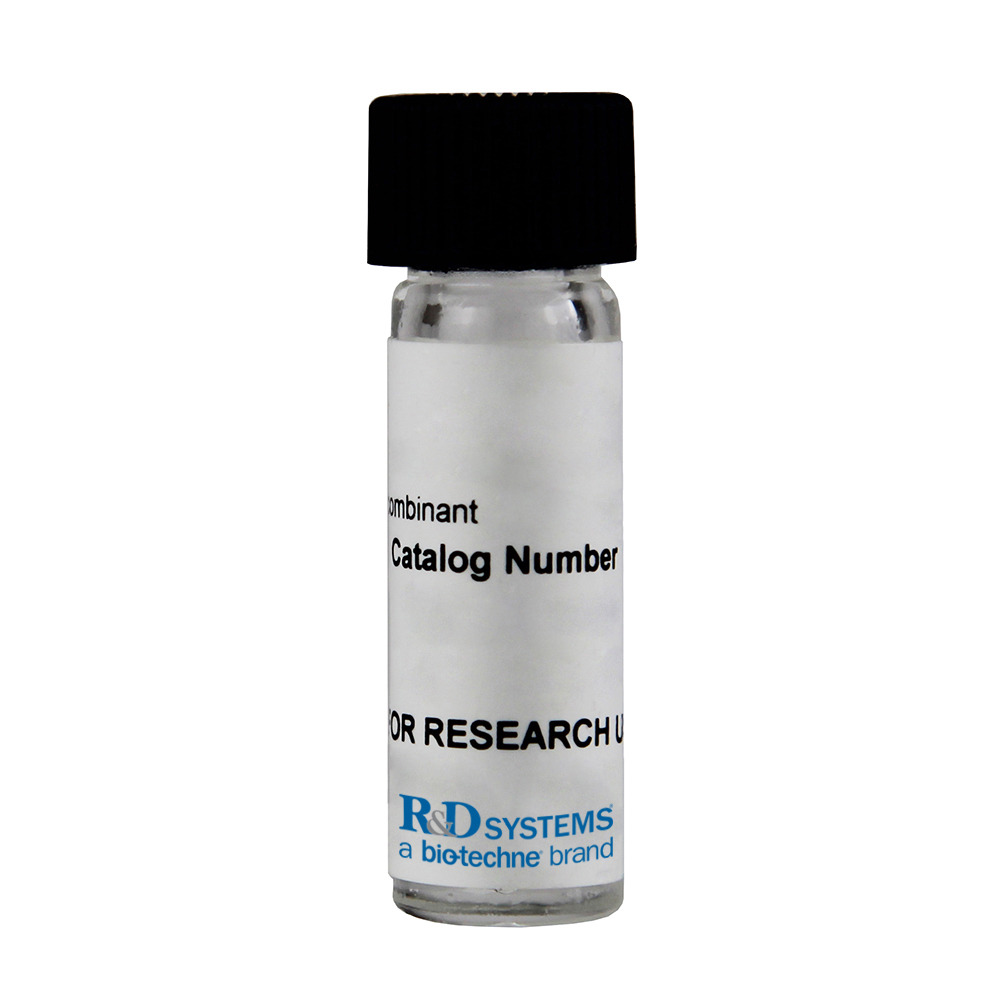Recombinant Rat Cystatin C Protein, CF Summary
Product Specifications
Met1-Ala140, with a C-terminal 6-His tag
Analysis
Product Datasheets
Carrier Free
CF stands for Carrier Free (CF). We typically add Bovine Serum Albumin (BSA) as a carrier protein to our recombinant proteins. Adding a carrier protein enhances protein stability, increases shelf-life, and allows the recombinant protein to be stored at a more dilute concentration. The carrier free version does not contain BSA.
In general, we advise purchasing the recombinant protein with BSA for use in cell or tissue culture, or as an ELISA standard. In contrast, the carrier free protein is recommended for applications, in which the presence of BSA could interfere.
6154-PI
| Formulation | Supplied as a 0.2 μm filtered solution in HEPES and NaCl. |
| Shipping | The product is shipped with polar packs. Upon receipt, store it immediately at the temperature recommended below. |
| Stability & Storage: | Use a manual defrost freezer and avoid repeated freeze-thaw cycles.
|
Assay Procedure
- Activation Buffer: 50 mM Tris, 5 mM DTT, pH 7.0
- Assay Buffer: 50 mM Tris, pH 7.0
- Recombinant Rat Cystatin C (rrCystatin C) (Catalog # 6154-PI)
- Papain (Sigma, Catalog # P4762)
- Substrate: Z-Phe-Arg-AMC (Catalog # ES009), 10 mM stock in DMSO
- F16 Black Maxisorp Plate (Nunc, Catalog # 475515)
- Fluorescent Plate Reader (Model: SpectraMax Gemini EM by Molecular Devices) or equivalent
- Dilute papain to 100 µg/mL in Activation Buffer.
- Incubate at room temperature for 15 minutes.
- Prepare a dilution curve of rrCystatin C (MW: 14,150 Da) in Assay Buffer. Make the following serial dilutions: 1000, 500, 250, 125, 83.3, 55.6, 37.0, 18.5, 9.26 and 4.63 nM.
- Dilute activated papain to 2 µg/mL in Assay Buffer.
- Mix equal volumes of the rrCystatin C curve dilutions and the diluted active papain. Include a papain control (in duplicate) containing Assay Buffer and the diluted active papain.
- Incubate mixtures at 37 ºC for 15 minutes.
- Dilute Substrate to 200 µM in Assay Buffer.
- Perform a five-fold dilution of the incubated mixture of rrCystatin C and Papain with Assay Buffer.
- Load into plate 50 µL of diluted incubated mixture, and start the reaction by adding 50 µL of 200 µM Substrate.
- Read at excitation and emission wavelengths of 380 nm and 460 nm, respectively, for 5 minutes in kinetic mode.
- Derive the 50% inhibition concentration (IC50) value for rrCystatin C by plotting RFU/min vs concentration with 4-PL fitting.
- Calculate the specific activity for Papain at each point using the following formula (if needed):
|
Specific Activity (pmol/min/µg) = |
Adjusted Vmax* (RFU/min) x Conversion Factor** (pmol/RFU) |
| amount of enzyme (µg) |
*Adjusted for Substrate Blank
**Derived using calibration standard 7-Amino, 4-Methyl Coumarin (AMC) (Sigma, Catalog # A-9891).
- Papain: 0.010 µg
- Substrate: 100 µM
- rrCystatin C: 50, 25, 12.5, 6.25, 4.17, 2.78, 1.85, 0.926, 0.463, and 0.2315 nM
Reconstitution Calculator
Background: Cystatin C
Cystatin C is a member of family 2 in the Cystatin superfamily (1). It is involved in processes such as tumor invasion and metastasis, inflammation and some neurological diseases. It inhibits many cysteine proteases such as papain and cathepsins B, H, K, L and S (2, 3). It is ubiquitous in human tissues and body fluids. A point mutation in the gene coding for the 120 amino acid mature Cystatin C causes a hereditary form of amyloid angiopathy in which the protein variant is deposited in the cerebral arteries, leading to fatal cerebral hemorrhage (4). Cystatin C may have additional clinical applications. For example, it is a good marker for glomerular filtration rate (5).
- Reed, C.H. (2000) British J. Biomed. Sci. 57:323.
- Janowski, R. et al. (2001) Nat. Struct. Biol. 8:316.
- Abrahamson, M. (1994) Methods Enzymol. 244:685.
- Abrahamson, M. et al. (1992) Hum. Genet. 89:377.
- Laterza, O.F. et al. (2002) Clin. Chem. 48:699.
Product Specific Notices
Coomassie is a registered trademark of Imperial Chemical Industries Ltd.Citation for Recombinant Rat Cystatin C Protein, CF
R&D Systems personnel manually curate a database that contains references using R&D Systems products. The data collected includes not only links to publications in PubMed, but also provides information about sample types, species, and experimental conditions.
1 Citation: Showing 1 - 1
-
Does swimming exercise affect experimental chronic kidney disease in rats treated with gum acacia?
Authors: Ali, Badreldi, Al-Salam, Suhail, Al Za'abi, Mohammed, Al Balushi, Khalid A, Ramkumar, Aishwary, Waly, Mostafa, Yasin, Javid, Adham, Sirin A, Nemmar, Abderrah
PLoS ONE, 2014-07-21;9(7):e102528.
Species: Rat
Sample Types: Plasma
Applications: ELISA (Standard)
FAQs
No product specific FAQs exist for this product, however you may
View all Proteins and Enzyme FAQsReviews for Recombinant Rat Cystatin C Protein, CF
There are currently no reviews for this product. Be the first to review Recombinant Rat Cystatin C Protein, CF and earn rewards!
Have you used Recombinant Rat Cystatin C Protein, CF?
Submit a review and receive an Amazon gift card.
$25/€18/£15/$25CAN/¥75 Yuan/¥2500 Yen for a review with an image
$10/€7/£6/$10 CAD/¥70 Yuan/¥1110 Yen for a review without an image


